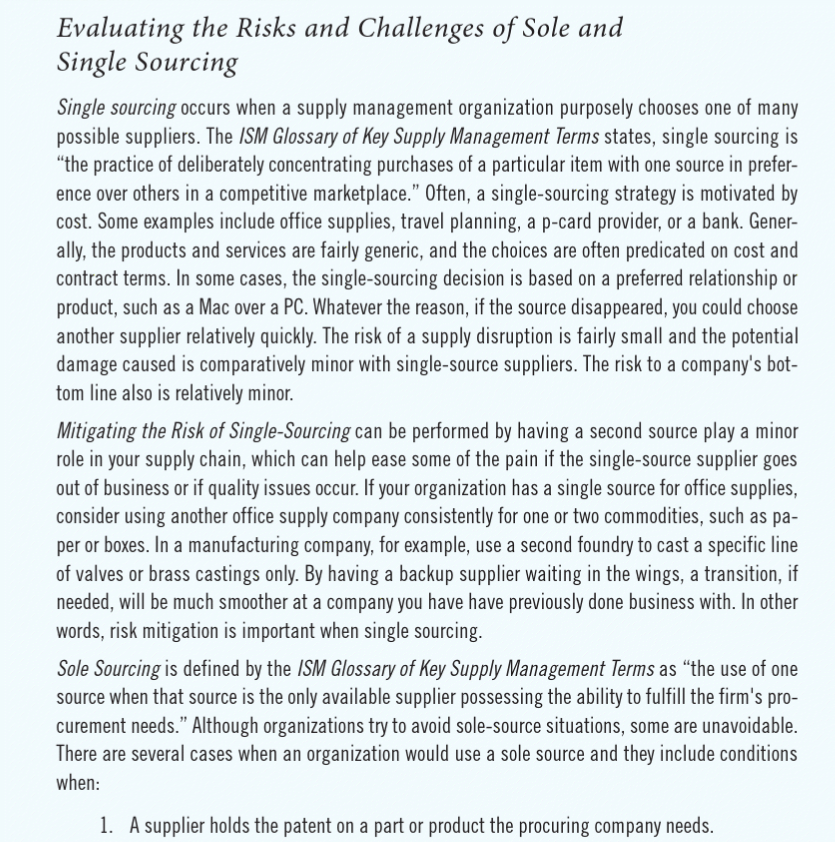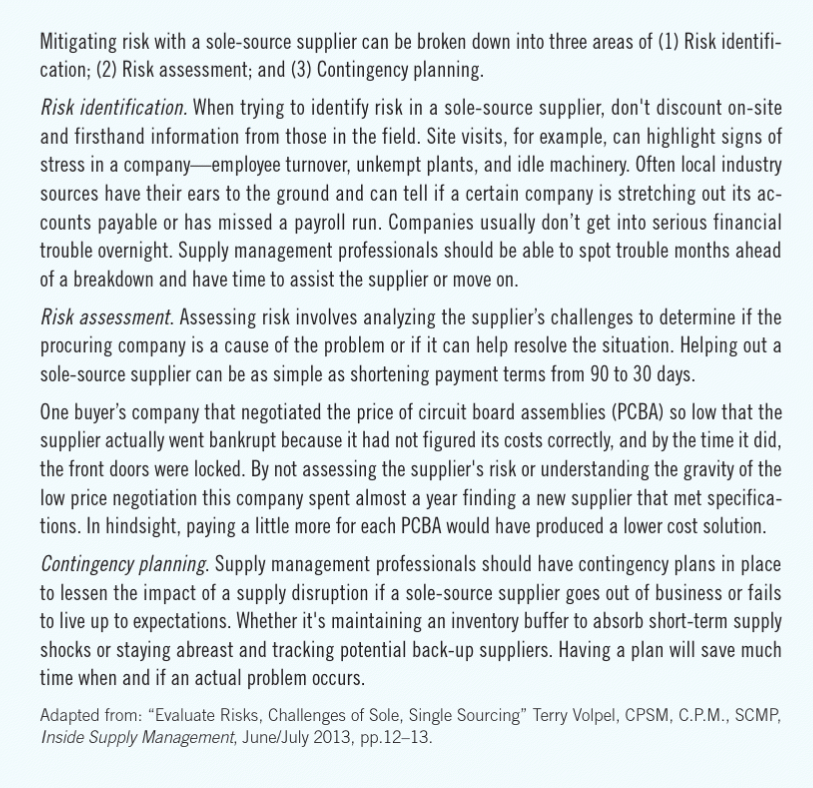can anyone explain this case to me or summarize ?
below:
Evaluating the Risks and Challenges of Sole and Singie Sourcing Singie seaming occurs when a supply management organization purposely chooses one of many possible supptiers. The Enid Giossary of Key Supply Management Terms states, single sourcing is \"the practice of deliberately concentrating purchases of a particular item with one source in prefer- ence over others in a competitive marketplace." Often, a single-sourcing strategy is motivated by cost. Some examples include office supplies, travel planning, a p-card provider, or a bank. Gener- ally, the products and services are fairly generic, and the choices are often predicated on cost and contract terms. In some cases, the single-sourcing decision is based on a preferred relationship or product, such as a Mac over a PC. Whatever the reason, if the source disappeared, you could choose another supplier relatively quickly. The risk of a supply disruption is fairly small and the potential damage caused is comparatively minor with single-source suppliers. The risk to a company's bot- tom Iine also is relatively minor. Mitigating the Risk of SingieSoorcing can be performed by having a second source play a minor role in your supply chain, which can help ease some of the pain if the single-source supplier goes out of business or if quality issues occur. If your organization has a single source for office supplies, consider using another office supply company consistently for one or two commodities, such as pa- per or boxes. In a manufacturing company, for example, use a second foundry to cast a specific line of valves or brass castings only. By having a backup supplier waiting in the wings, a transition, if needed, will be much smoother at a company you have have previously done business with. In other words, risk mitigation is important when single sourcing. Soie Sourcing is defined by the 15M Glossary of Key Snppiy Management forms as \"the use of one source when that source is the only available supplier possessing the ability to fulfill the firm's pro- curement needs.\" Although organizations try to avoid sole-source situations, some are unavoidable. There are several cases when an organization would use a sole source and they include conditions when: 1. A supplier holds the patent on a part or product the procuring company needs. 1. A supplier holdsthe patent on a part or product the procuring company needs. 2. Only one company is licensed to produce a certain item or holds the intellectual property rights to a needed product or service. 3. Acustom part is needed by a company and the tooling costs for the custom part are very expensive. In this case if the buyer chooses to purchase the tooling then the sole source could become a single source if other suppliers can moire the item. 4. Only one company has the most efficient process to produce a product, making it signi- cantly less expensive than any alternative. 5. Your company holds patent rights and intellectual property that need to be carefully guarded. In this case. the supply management organization chooses one supplierto produce the item to avoid sharing sensitive information with a variety of suppliers. In this type of scenario, supply management professionals must first look down security provisions in a detailed contract. As is illustrated above, in cases 3. 4. and Suther suppliers are available rnalting the "sole" supplier designation less firm. Software is a classic example of the above conditions. Though it is possible to make a change if your software provider goes out of business. it can be expensive and time- consuming. Unfortunately, sole sourcing opens your company to a greater risk of supply disruption. Mitigating risk with a sole-source supplier can be broken down into three areas of [1) Risk identifi- cation; [2} Risk assessment; and (3) Contingency planning. Risk identification. When trying to identify risk in a sole-source supplier, don't discount on-site and firsthand information from those in the field. Site visits, for example, can highlight signs of stress in a companyemployee turnover, unkempt plants, and idle machinery. Often local industry sources have their ears to the ground and can tell if a certain company is stretching out its ac- counts payable or has missed a payroll run. Companies usually don't get into serious financial trouble overnight. Supply management professionals should be able to spot trouble months ahead of a breakdown and have time to assist the supplier or move on. Risk assessment. Assessing risk involves analyzing the supplier's challenges to determine if the procuring company is a cause of the problem or if it can help resolve the situation. Helping out a sole-source supplier can be as simple as shortening payment terms from 90 to 30 days. One buyer's company that negotiated the price of circuit board assemblies lPCBlll so lowthat the supplier actually went bankrupt because it had not ligured its costs correctly. and by thetime it did, the front doors were locked. By not assessing the supplier*s risk or understanding the gravity of the low price negotiation this company spent almost a year finding a new supplier that met specifica- tions- In hindsight. paying a little more for each PCBA would have produced a lower cost solution. Contingency planning. Supply management professionals should have contingency plans in place to lessen the impact of a supply disruption if a sole-source supplier goes out of business or fails to live up to expectations- Whether it's maintaining an inventory buffer to absorb short-term supply shocks or staying abreast and tracking potential back-up suppliers- Having a plan will save much time when and it an actual problem occurs. Adapted from: \"Evaluate Risks, Challenges of Sole, Single Sourcing\" Terry Velpel, CPSM, C.P.M., SCMF', inside Supply Management, JuneiJuly 2013, pp.1213









